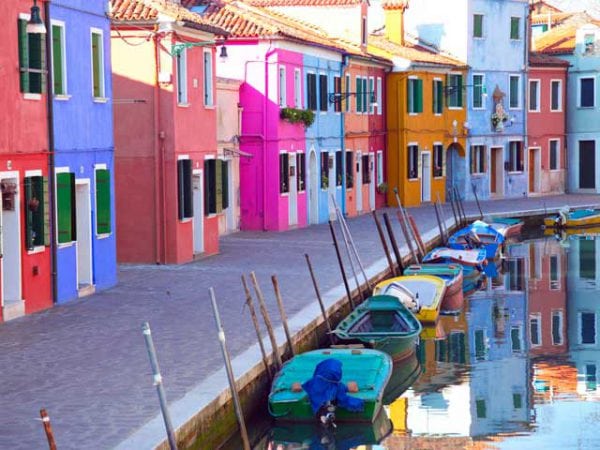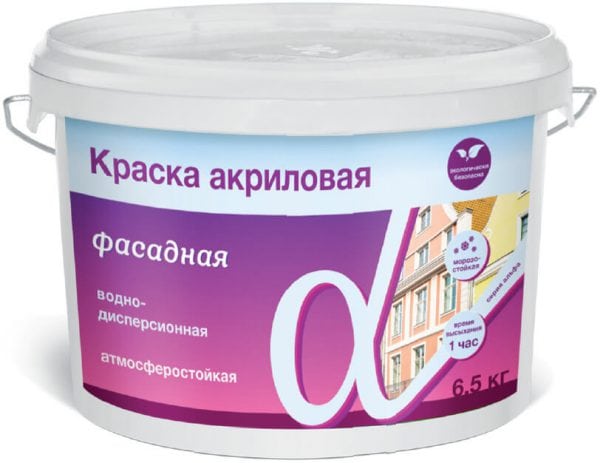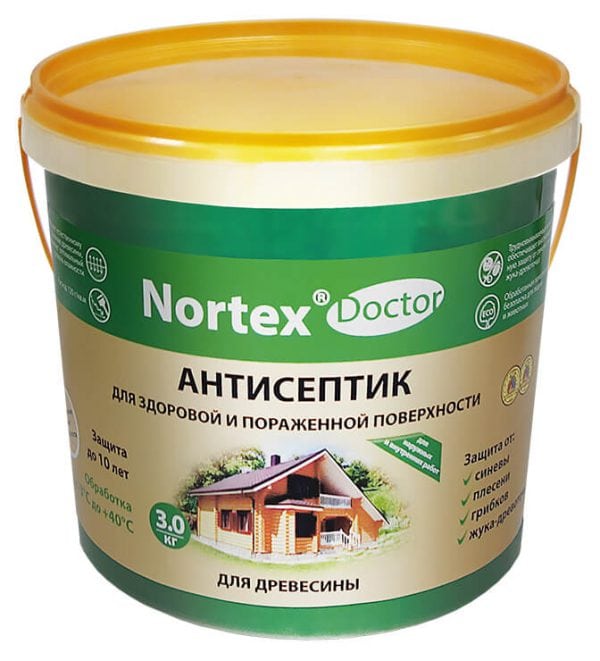Acrylic facade paint is one of the best solutions for finishing work outdoors. This article will discuss the performance characteristics of acrylic compositions, their application technologies, as well as an overview of the most famous brands on the domestic market.
- The composition of acrylic paints
- Advantages of acrylic paints
- The main characteristics of acrylic compositions
- Features of paint consumption
- Staining technology
- Tinting
- Painting wood surfaces
- Manufacturers Overview

The composition of acrylic paints
Acrylic coating is a thin plastic layer. The characteristics of the plastic may vary depending on the scope of the composition, however, in the main structure of this material remains the same.
The main characteristics of acrylic compositions:
- The binder is based on polymers that can be soluble in water or an organic solvent. Polymers are responsible for film formation as well as retention of color pigments and additives.
- Another important component of paints is color pigments. These substances are made from acrylic resins. The polymers and pigments combined into a single structure form a durable surface that can withstand loads and environmental influences.
- Additives and fillers. These elements are added to the composition to give it those or other operational qualities. For example, with fillers you can get a glossy or matte surface tone. Also, additives can achieve water-repellent qualities, antiseptic, fireproof and other necessary properties.
Polyacrylic paints are made on the basis of polymers and copolymers of alkyl acrylates. Acrylates and methacrylates, as well as styrene, are added to the copolymers to obtain the desired glass transition temperature. If necessary, special fillers can be added, for example, marble chips.
Resins included in acrylic paints include special groups of elements that make coatings more durable. Powder coatings are made using epoxy, hydroxyl, and carboxyl groups.
Advantages of acrylic paints
At the end of staining, a special film with good adhesive properties is formed on the surface. Adhesion characterizes the level of adhesion between dissimilar materials. The plastic film formed during coloring serves as a barrier between the substrate (for example, metal) and the external environment (humidity, precipitation, etc.).
The main advantages of acrylic compositions are listed below:
- Increased heat resistance and resistance to moisture means that the material will not crack when the temperature changes, and also withstand in too dry or wet weather.
- The duration of operation of acrylic coatings reaches 15-20 years.
- Acrylic exterior paints are easy to apply and dry quickly.
- Acrylic compounds do not produce elements harmful to humans and are free from pungent odors.
- There is a wide variety of colors, as well as the possibility of tinting. The latter means that even in the absence of the desired color, you can always apply white paint to the surface, and then tint.
Acrylic compounds are made on one of two bases: solvents or water. Solvent-based paints are more adapted to extreme climatic conditions, especially for low temperatures.
The main characteristics of acrylic compositions
Acrylic paints must meet the following parameters:
- The dried surface should not be wrinkled, have smudges or peeling.
- The content of non-volatile components is 52-57% (water dispersion formulations), 64-67% (solvent based formulations).
- The pH level is from 6.5 to 9.5.
- The spreading rate is not more than 100 g per 1 m2 (white color) and not higher than 120 g per 1 m2 (other colors).
- Resistance to constant exposure to water under standard conditions - 24 hours.
- Resistance to cold at least 5 cycles.
- Resistance to light no more than 5%.
- Washability not higher than 2.5-3.5 g / 1m2.
- Operational duration not less than 10 years.
- 10. The drying time for the surface is from 6 to 30 hours.
- 11. The milling indicator is not more than 60 microns.
These requirements are presented by GOST, therefore, all legal manufacturers offer products that comply with these standards.
to contents ↑Features of paint consumption
The specific consumption figures per m2 depend on the type of mortar, the material from which the facade is made, the thickness of the paint layer, the proportions between the paint composition and the solvent. For example, for smooth surfaces, paint consumption is minimal. However, the flow rate increases if the surface is porous and not very smooth. Depending on the type of surface, the paint consumption is from 300 to 400 g per m2.
If the composition is diluted with a solvent, the cost of painting will be slightly higher. However, it is solvents that are recommended for some facade paints.
Staining technology
Before starting the painting process, it is necessary to prepare the surface. First, we clean the walls of dirt, howls, whitewash, exfoliated concrete, etc. When the wall dries, it starts priming using an acrylic primer with deep penetration. Primer consumption is 100 to 150 g per m2. It is not worth saving the primer, since it is an important factor in the quality of the paint.
Note! It is recommended to use a primer from the same manufacturing company as the paint.
Apply the primer with a spray gun or brush. If the surface is uneven, it is undesirable to use the roller. It is most convenient to work with a spray, but if the wind blows, the material consumption will increase.
The primer dries from 30 minutes to several hours. Loose surfaces are recommended to be primed twice.
When the surface dries, proceed to its coloring. The paint is sensitive to temperature conditions: at temperatures below 5 degrees Celsius, it is impossible to paint. If the temperature of the paint material is less than 20 degrees, it must be heated. The fact is that the consumption of cold paint becomes increased. You should also pay attention to the production date of the composition. If the paint has survived the winter, then there is a risk of freezing. Such a composition will be unsuitable for use.
to contents ↑Tinting
The main color of acrylic paints is white. Therefore, most often the surface is tinted. If it is a small area and the paint consumption is not more than 10 liters, you can tint yourself. To do this, add dyes and mix well the composition. However, it would be more correct to tint at the tinting station of the paint manufacturer, if the amount of work is significant. In this case, the same shade of compositions in all buckets is guaranteed.
Before use, mix the paint well with a mixer. Apply the composition to the surface with a roller, brush or spray.We proceed from the same principles of using the tool depending on the type of surface that was described above.
A spray gun is the most convenient way to apply paint, especially suitable for large surfaces. To work with this device, the paintwork is diluted with water. According to the recommendations of manufacturers, water should be no more than 10%. However, in reality, the sprayer will work fine if at least 5 liters of water are poured onto a bucket of paint.
The recommended number of layers is from 2 to 3. Each subsequent layer is applied only after the previous one dries.
The consumption of paint material depends on the method of painting. When working with a spray gun, this figure will be approximately 400 g per m2. If you use a brush, the consumption will be less - approximately 300 g per m2.
to contents ↑Note! The use of acrylic compounds is meaningless if the surface is constantly wetted under operating conditions. In such cases, it is better to give preference. silicate facade paint.
Painting wood surfaces
First of all, the wood should be as dry as possible. Without drying, you can paint the facade only if it is made from glued beams.
All end parts of wooden products are treated with sealant. Moreover, sealants should be exclusively water-based. Such compositions will protect the wood from excessive moisture, and at the same time they will not prevent fumes from leaving the material.
As always, before painting any surface, you need to carry out preparatory work. First we remove dirt, dust and other debris from the facade, which can interfere with good adhesion. Next, grind the surface with sandpaper. Another option is the application of an adhesive primer. We process the polished surface with an antiseptic. When choosing an antiseptic, we give preference to a composition in which there are additives that protect wood from decay, harmful insects, and ultraviolet radiation.
Apply the paintwork with a wide brush. Movement - in the direction of the fibers. When the paint dries, we grind the surface. Then you need to apply at least one more coat of paint.
to contents ↑Manufacturers Overview
The domestic market presents a wide variety of acrylic mixtures for painting facades. Moreover, not only foreign but also domestic manufacturers offer their products.
Below are just a few of the popular brands:
- The Lakra trademark offers latex facade mixtures. Lacra paints form white coatings with the possibility of further tinting.
- Paints of the well-known brand “Ceresit” are intended, first of all, for facades treated with plaster. Moreover, the plastered walls can have both mineral and acrylic top plaster coatings. Despite its main purpose, “Ceresit” can be used for painting other surfaces (for example, roofs), as it has a high water-repellent ability.
- "Halo" paints can be used for painting brick, wood, asbestos-cement, plastered surfaces. Differ in the increased vapor permeability. These compositions can be tinted with all kinds of shades.
- Compositions from the Parade trademark are used both for painting concrete, brick, putty, and for metal surfaces. The painted surface is vapor permeable, self-cleaning and resistant to ultraviolet radiation.
- Facade paint "VGT" fits well on any surface. Several types of mixtures are available for creating matte and glossy shades.
- Paint of the Admiral trademark is intended for coloring facades with a high load during operation.It is characterized by high resistance to external influences and good adhesion.
- Facade mixes “Dulux” are specially adapted for frosty and humid climate. Such compositions can be used for staining the basement level. They are applied only on a mineral base and are not recommended for use in residential buildings.
- “Acrial Lux” is offered for regions that are characterized by sharp temperature changes. Paint perfectly lays on any surface even in the winter season.
- Tikkurila is an excellent option for previously painted surfaces. It is undesirable to apply this paint on lime or silicate coatings. The mixture goes well with mineral surfaces and ceramics.
Preparation and painting of facade surfaces with acrylic paints is quite affordable even for a novice master. You just need to choose the right composition (for this it is advisable to consult with a sales assistant) and adhere to the instructions for staining, which is provided in this article.













Hello. Advise the facade paint, the house is insulated with polystyrene foam, glued to the grid with glue (not putty)